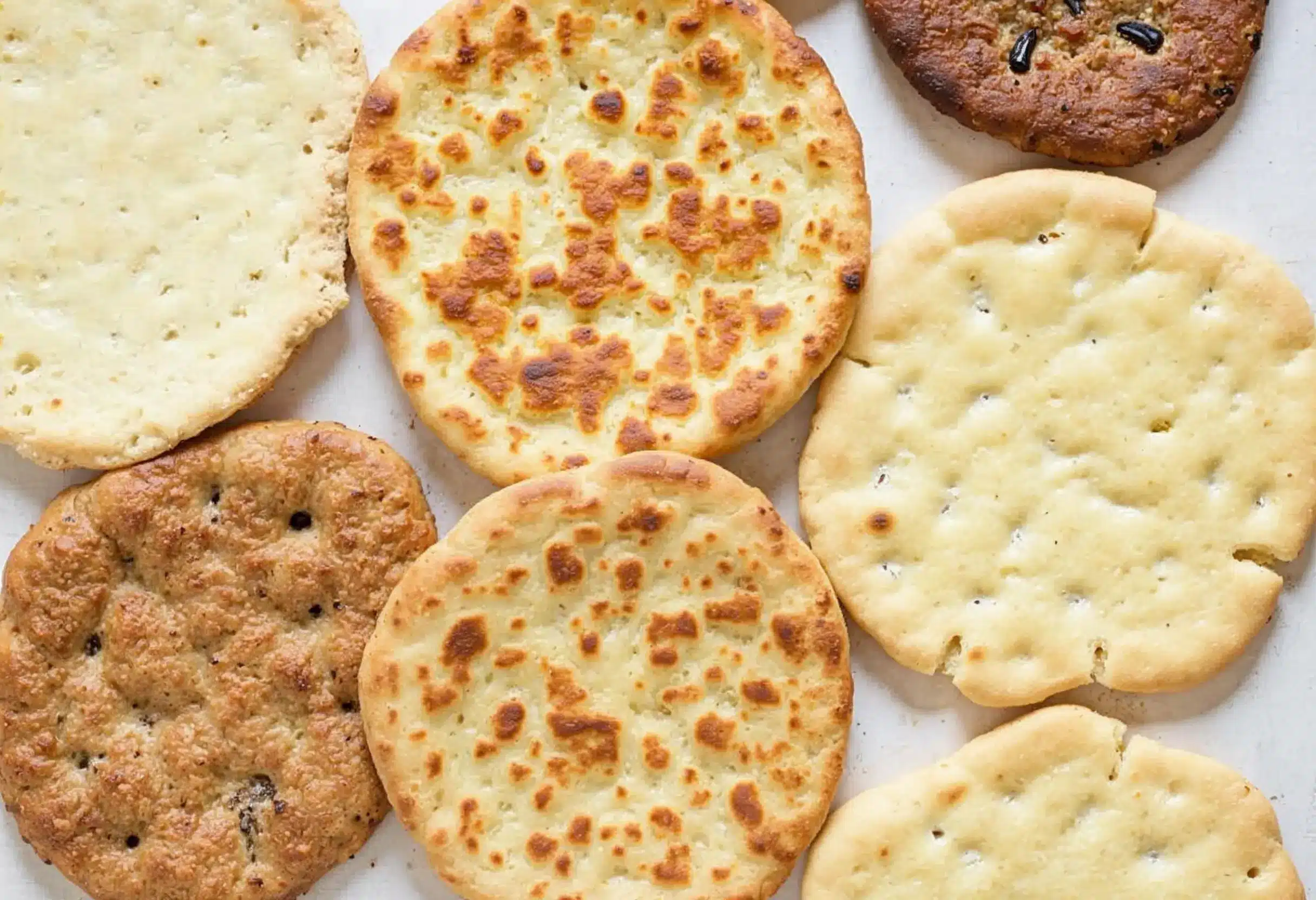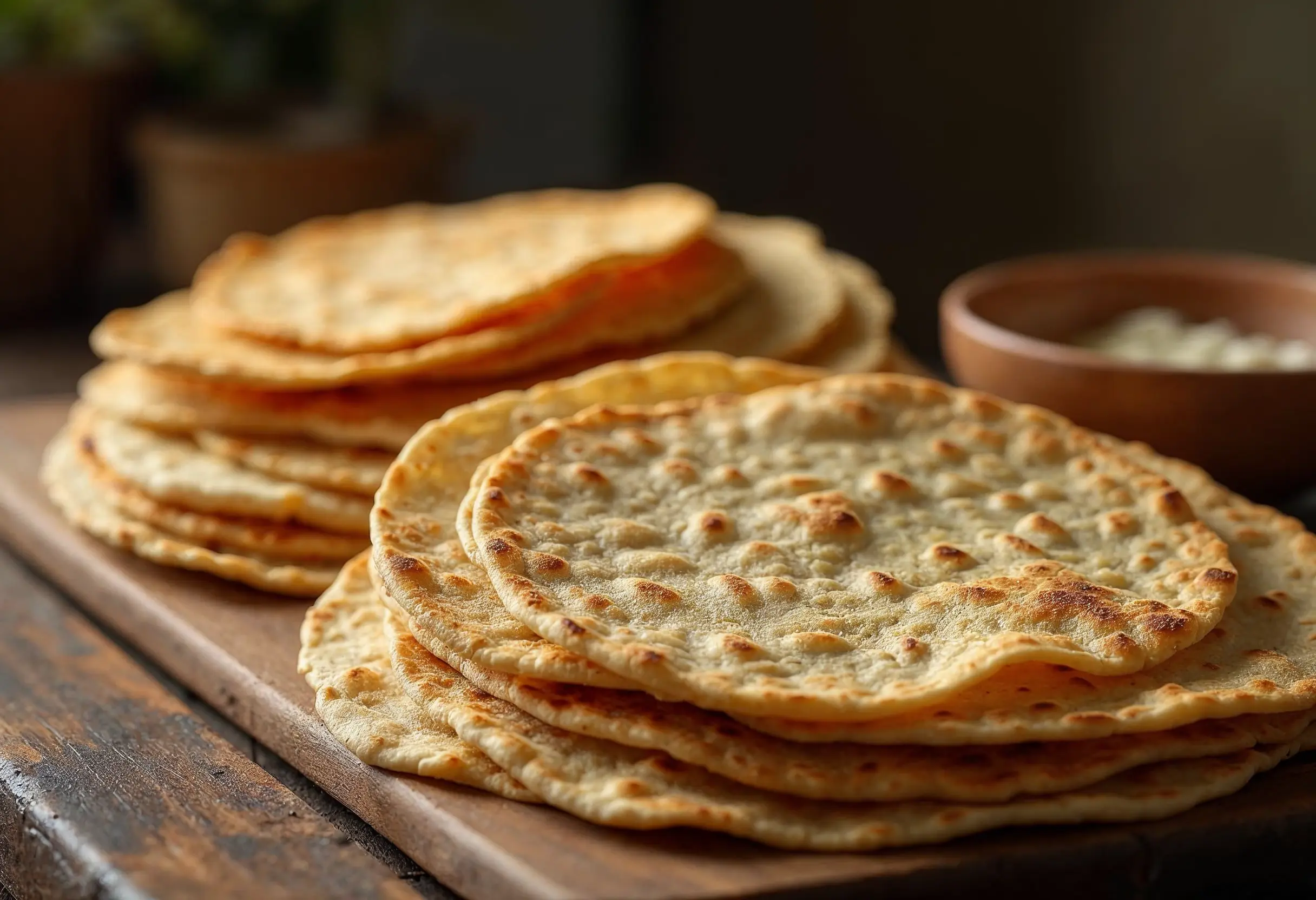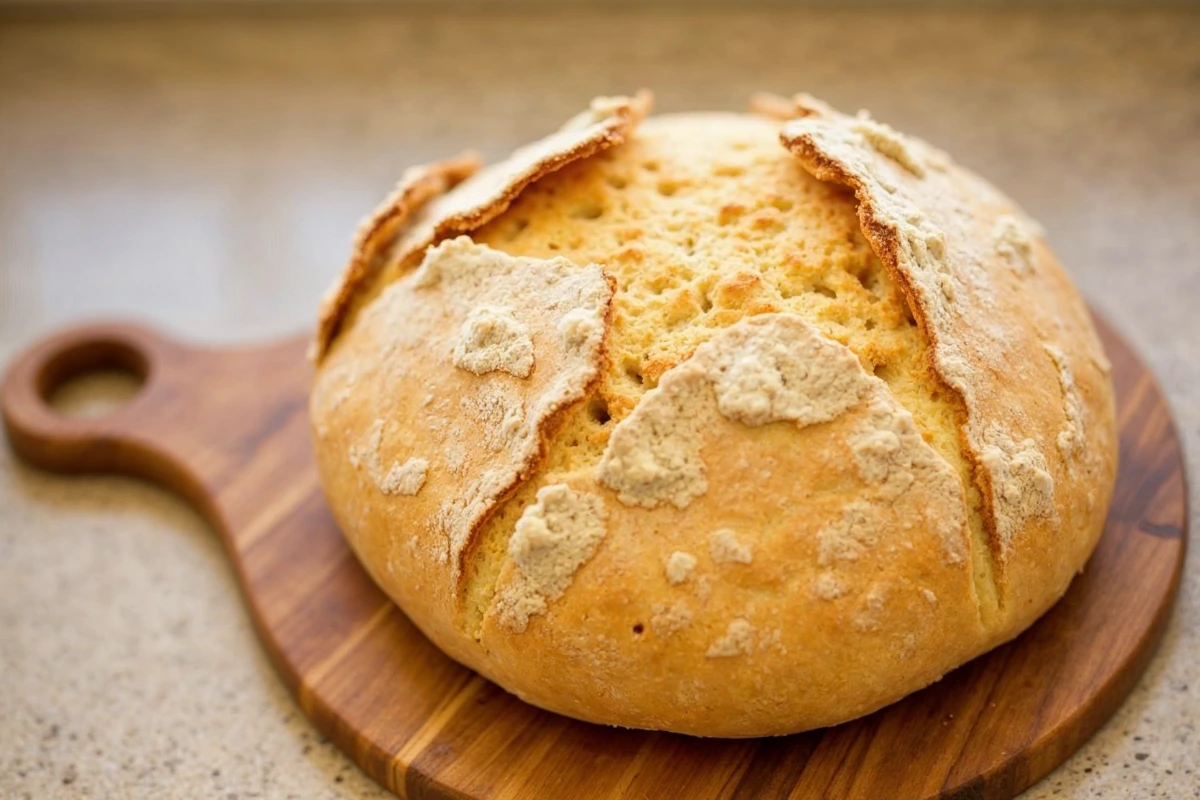Which Type of Bread Is Made Without Yeast?
Bread has been a staple food for centuries, yet not all bread relies on yeast. In fact, yeast-free breads serves as a versatile and delicious alternative, making it perfect for those with dietary restrictions, health concerns, or even anyone simply looking for simpler, quicker recipes.
Unlike traditional bread, yeast-free breads skips the typical leavening process, instead relying on alternatives like baking soda, baking powder, or no leavening at all. As a result, this creates a wide variety of textures and flavors, ranging from dense and hearty loaves like soda bread to soft flatbreads such as tortillas.
Want to save this recipe?
Enter your email to get it sent to your inbox! Plus you'll get new recipes from us every week.
For many, yeast-free breads becomes a necessity—especially for individuals dealing with yeast sensitivities or conditions like candida overgrowth. Meanwhile, others turn to these breads for religious observances, such as consuming unleavened bread during Passover. Even for those without dietary restrictions, yeast-free recipes still offer the added convenience of requiring fewer ingredients and less preparation time.
Moreover, yeast-free breads go beyond practicality by celebrating global culinary traditions. For instance, Irish soda bread, Middle Eastern lavash, and Scandinavian crispbreads showcase unique techniques and flavors that have been carefully passed down through generations.
In this guide, we’ll thoroughly explore popular yeast-free breads types, their benefits, and how you can easily bake them at home. So, whether you’re a beginner or an experienced baker, there’s undoubtedly something here for everyone to enjoy!
Table Of Contents
What Is Yeast-Free Breads?
What Does Yeast-Free Bread Mean?
Yeast-free breads is any type of bread that excludes yeast, the traditional leavening agent that makes dough rise. Instead, it uses alternatives like baking powder, baking soda, or no leavening at all. Some yeast-free bread remains flat and dense, showcasing unique qualities often overlooked in traditional bread.
Why Choose Yeast-Free Breads?
Yeast-free breads isn’t just for those with yeast intolerance or allergies. It also caters to specific religious practices, such as the consumption of unleavened bread during Passover. Additionally, yeast-free recipes often require less preparation time, making them a favorite among busy home bakers.
Who Should Eat Yeast-Free Bread?
- Those with yeast sensitivity: People suffering from Candida overgrowth or similar conditions often avoid yeast in their diet.
- Cultural observances: Many religions incorporate unleavened bread into ceremonies.
- Quick bakers: Yeast-free bread is perfect for individuals looking to whip up a loaf without waiting for proof.
Top Types of Bread Made Without Yeast

Unleavened Bread: The Ancient Staple
Unleavened bread, also known as “flatbread,” has deep historical roots and is often associated with religious and cultural traditions.
- Biblical Context: Unleavened bread, or matzo, was consumed by Israelites during the Exodus as they left Egypt in haste, with no time to let their bread rise.
- Modern Examples: Matzo crackers, widely used during Passover.
Soda Bread: Ireland’s Quick Bread
Soda bread uses baking soda and an acidic liquid (like buttermilk) to create a quick chemical reaction, causing the dough to rise.
- Texture and Flavor: Dense, moist, and slightly tangy.
- Common Variations: Brown soda bread (made with whole wheat flour) and white soda bread (made with refined flour).
Flatbreads from Around the World
Flatbreads are a universal yeast-free bread that varies significantly depending on the region:
- Tortillas (Mexico): Soft and pliable, tortillas serve as the foundation for tacos, burritos, and quesadillas.
- Chapati (India): A staple in Indian households, chapati is cooked on a skillet without leavening agents.
- Lavash (Middle East): Thin and flexible, lavash is often served alongside hummus or kebabs.
Gluten-Free Yeast-Free Breads Options
For individuals avoiding yeast and gluten, bread made with almond, chickpea, or rice flour provides satisfying alternatives. These options often use eggs or xanthan gum to maintain structure and texture.
Other Yeast-Free Breads to Explore
- Cornbread: A Southern favorite made with cornmeal, often baked with buttermilk and baking soda.
- Rye Crispbread: these crunchy crackers are popular in Scandinavia for topping with cheese or smoked fish.
Yeast-Free Bread Recipes to Try at Home

Soda Bread Recipe
Ingredients:
- 4 cups all-purpose flour
- 1 tsp baking soda
- 1 tsp salt
- 1¾ cups buttermilk
Steps:
- Preheat your oven to 375°F (190°C).
- Mix flour, baking soda, and salt in a large bowl.
- Gradually add buttermilk, stirring until a dough forms.
- Knead briefly, shape into a round and place on a baking sheet.
- Bake for 30–35 minutes or until golden brown.
Unleavened Bread Recipe
Ingredients:
- 2 cups whole wheat flour
- ¾ cup water
- 1 tsp salt
Steps:
- Combine flour and salt in a bowl, then add water to form a dough.
- Divide dough into small balls, roll thin, and cook on a hot skillet until lightly browned.
Simple Tortilla Recipe
Ingredients:
- 2 cups flour
- ½ tsp salt
- ¾ cup water
- 3 tbsp vegetable oil
Steps:
- Mix flour and salt, then slowly add water and oil.
- Knead into a soft dough, and let rest for 10 minutes.
- Roll into circles and cook on a dry skillet for 1–2 minutes per side.
Is Sourdough Bread Truly Yeast-Free?
Sourdough bread occupies a unique space in the bread world. While it doesn’t use commercial yeast, it relies on naturally occurring wild yeast and bacteria for fermentation.
Wild Yeast vs. Commercial Yeast
Wild yeast, captured during the fermentation process, produces the same rising effect as commercial yeast but offers additional benefits like improved digestibility and a tangy flavor.
Is Sourdough Toast Yeast-Free?
Sourdough toast still contains yeast, but it’s naturally derived. Some individuals with yeast sensitivities can tolerate sourdough better than commercial yeast-based breads.
The Fermentation Advantage
Fermentation breaks down complex carbohydrates, making sourdough easier to digest and potentially more nutritious.
Health Benefits of Yeast-Free Breads
Why Yeast-Free Breads Appeals to Health-Conscious Consumers
Yeast-free bread often uses fewer ingredients, resulting in a more natural, wholesome product.
Health Comparisons
- Lower Sugar Content: Yeast-free breads generally contains less sugar, reducing overall calorie intake.
- Easier to Digest: These breads may be gentler on sensitive stomachs, free from fermentation gases.
Yeast-Free Breads Across the Globe
Middle Eastern Lavash and Pita
Both are staples of Middle Eastern cuisine, with pita occasionally being slightly leavened but often yeast-free.
Ethiopian Injera
A spongy, tangy flatbread made from teff flour, traditionally paired with stews and curries.
Scandinavian Crispbreads
Crunchy and long-lasting, crispbreads are a favorite in countries like Sweden and Finland.
Myths About Yeast-Free Breads
Myth 1: Yeast-Free Breads Doesn’t Rise
Truth: Baking soda and baking powder are effective substitutes that create a good rise.
Myth 2: Yeast-Free Breads Is Hard to Make
Truth: Many yeast-free recipes are beginner-friendly and require no kneading or long proofing times.
Myth 3: Yeast-Free Breads Tastes Bland
Truth: With creative additions like herbs, spices, or cheese, yeast-free bread can be flavorful and aromatic.
Stay Connected for More Delicious Recipes!
Love trying new and exciting recipes? Don’t miss out! Follow me for daily kitchen inspiration, exclusive cooking tips, and mouthwatering food ideas.
🔹 Facebook: Follow me here
🔹 Instagram: Join me here
🔹 Pinterest: Join me here
Let’s turn every meal into a masterpiece—one recipe at a time! Tag me when you try my dishes, and share your creations. Happy cooking! 🍓🔥 #PanoramaRecipes
FAQs About Yeast-Free Breads
Which breads are made without yeast?
Popular options include soda bread, tortillas, chapati, matzo, cornbread, and crispbreads.
What bread is made without yeast in the Bible?
Unleavened bread, or matzo, is referenced in the Bible.
Is sourdough bread yeast-free?
No, sourdough contains natural wild yeast.
Is no yeast bread healthier?
Yes, many yeast-free breads are less processed and easier to digest.
Which bread is most commonly made without yeast?
Soda bread and flatbreads are among the most popular.
Tips for Perfect Yeast-Free Bread
Use Quality Ingredients
- Whole wheat or rye flour enhances flavor and nutrition.
- Use fresh baking soda or powder for better results.
Experiment with Additions
- Add seeds, nuts, or herbs to elevate the taste and texture of yeast-free bread.
Don’t Overmix the Dough
- Overmixing can lead to tough, dense bread.
Conclusion: The Beauty of Yeast-Free Baking
Yeast-free bread is truly a celebration of simplicity and diversity in baking. Across cultures, it has been carefully crafted for centuries using local ingredients to create unique flavors and textures. For example, from the crisp crunch of Scandinavian rye crispbreads to the soft pliability of Indian chapati or the hearty richness of Irish soda bread, yeast-free breads reflect the creativity and tradition of global cuisine.
One of the greatest advantages of yeast-free bread, however, is its accessibility. With just a few pantry staples and no long proofing times, anyone can quickly create a warm, satisfying loaf in under an hour. This simplicity, in particular, makes it ideal for busy schedules, beginner bakers, and those seeking quick, wholesome alternatives.
Additionally, yeast-free breads are also a healthier choice for many people, as they offer fewer additives, lower sugar content, and easier digestibility. Whether you’re avoiding yeast for dietary reasons or simply want to try something new, these breads consistently provide a delicious, natural option that suits various preferences.
Therefore, embrace the joy of yeast-free baking today! With so many variations and easy recipes to explore, you’re sure to find a favorite that fits both your taste and lifestyle. From quick soda breads to versatile flatbreads, the possibilities are virtually endless. Start baking now and savor the simplicity!

